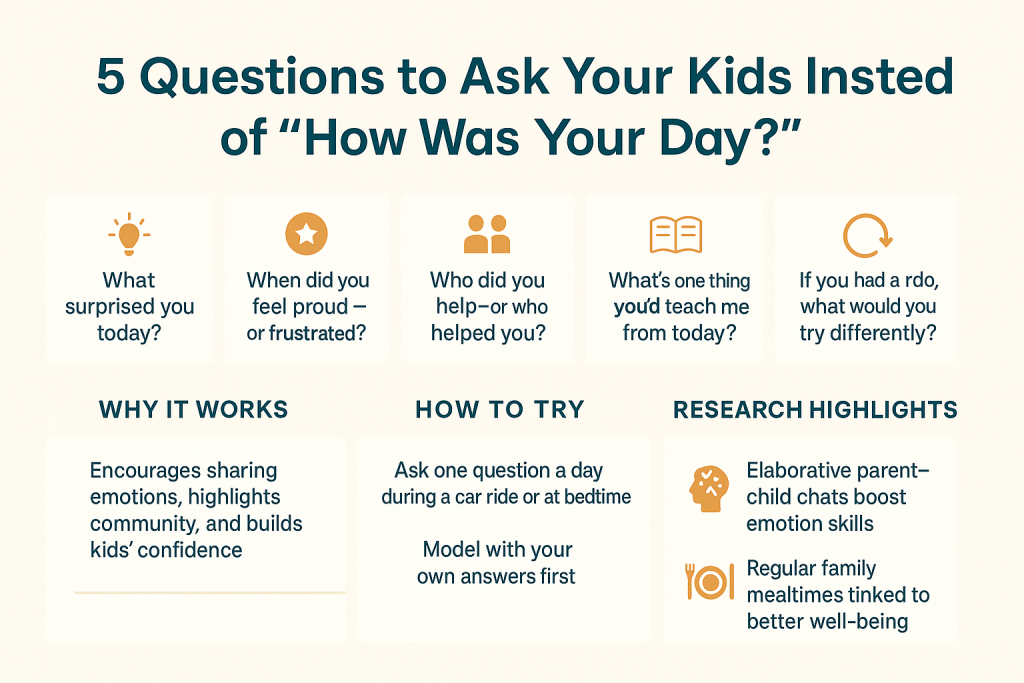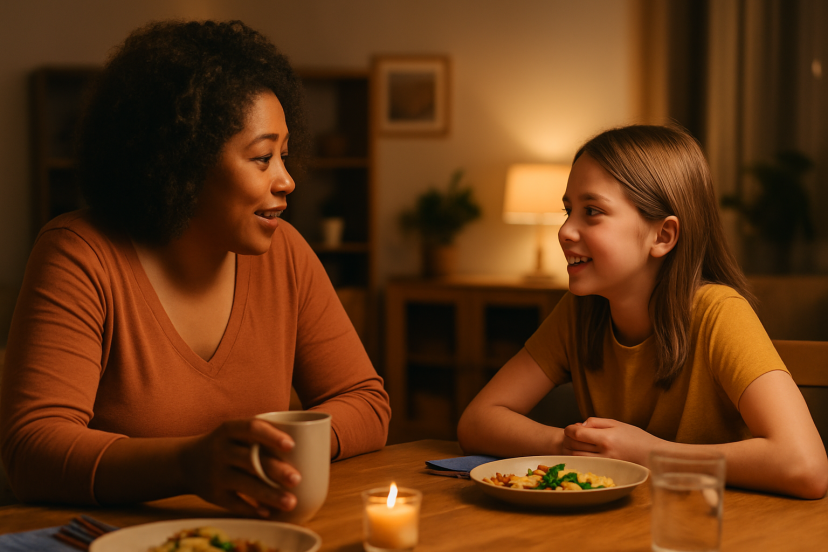5 Questions to Ask Your Kids Instead of “How Was Your Day?”
We may earn a commission for purchases made using our links. Please see our disclosure to learn more.
If you’ve ever asked “How was your day?” and gotten “Fine,” you’re not alone. That question is easy—but it rarely opens a real conversation. The good news? A few thoughtful, specific prompts can turn car rides, dinner time, or bedtime into meaningful moments where your child feels seen, heard, and safe. In this guide, we’ll walk through five better questions (with age-wise variations, follow-ups, and gentle scripts), plus practical routines, product picks to spark talk, and a quick research-backed section so you know this approach is grounded in evidence. Throughout, we’ll naturally weave in questions to ask your kids that invite stories—not one-word answers.
Why “How Was Your Day?” Falls Flat
It’s vague, it puts kids on the spot, and it sounds like a test. Kids often scan for “the right answer” and default to short replies. Swap it for prompts that aim at emotions, moments, and choices—things kids naturally like to share.
How to Use These Questions (Without Feeling Forced)
- Pick the right window: car rides, snack time, walks, or winding down at night.
- Start small: one question a day is plenty.
- Model first: offer your own answer before you ask for theirs.
- Normalize passing: “You can skip this one if you want.” Pressure shuts conversation down.
1) “What surprised you today?”
Why it works
Surprises are tiny stories. They nudge kids to recall a specific moment and attach a feeling to it.
Follow-ups you can try
- “What was the best part about that surprise?”
- “If it happens again, what would you do the same—or differently?”
Age-wise tweaks
- Preschool: “What made you say ‘wow!’ today?”
- Elementary: “What did you learn that you didn’t expect?”
- Tweens/Teens: “What took you off-guard (in a good or tricky way)?”
Mini challenge
For one week, ask this at snack time. Jot answers in a shared notes app to build a “surprise scrapbook.”

2) “When did you feel proud—or frustrated?”
Why it works
It validates effort and emotion, not just outcomes. You’ll hear about wins and wobbles.
Gentle scripts
- “Proud is like that warm ‘I did it’ spark. Did you feel that today?”
- “Frustrated is when your brain says ‘ugh.’ What brought that up?”
Try this
Offer a quick, non-fixing response: “Thanks for telling me. That sounds tough. Want ideas—or a cheerleader?”
3) “Who did you help—or who helped you?”
Why it works
It builds empathy and highlights community. Kids start noticing kindness around them.
Follow-ups
- “How did you know they needed help?”
- “If you could thank someone again, what would you say?”
Cultural note
In some families, kids are encouraged to put group harmony first. This question honors that—community wins count as personal wins.
4) “What’s one thing you’d teach me from today?”
Why it works
Kids love being the expert. Teaching cements learning—and boosts confidence.
Try this
Hand them the “teacher’s tools”: a sticky note, a whiteboard, or your phone’s voice memo to “record the lesson.”
5) “If you had a redo, what would you try differently?”
Why it works
It invites a growth-mindset moment without shame. Mistakes become experiments.
Follow-ups
- “What’s step one?”
- “Want to rehearse it together right now?”
Conversation Starters for Different Ages
Preschool (3–5):
- “What color was your day?” (Let them pick a crayon.)
- “Which game did your hands play?”
Elementary (6–10):
- “What was the funniest thing you heard?”
- “What did you build, draw, or figure out?”
Middle School (11–13):
- “What made you think hard today?”
- “Who surprised you—in a good way?”
High School (14–18):
- “Where did you feel most like yourself?”
- “What’s one small choice today that will matter in a week?”
For Neurodivergent Kids & Different Communication Styles
- Offer either/or choices first (“proud or frustrated?”).
- Use visual aids: emoji cards, color scales, or a “feelings thermometer.”
- Accept non-verbal replies: thumbs up/down, a drawing, or a quick playlist pick.
- Keep sensory context in mind: pause questions if the environment is loud, bright, or crowded.
Make It a Ritual (So It Sticks)
Micro-habit idea: After you set down the water glasses at dinner, ask one question. That’s your cue.
Weekly rhythm:
- Mon: Surprise
- Tue: Proud/Frustrated
- Wed: Help/Got Help
- Thu: Teach Me
- Fri: Redo
Weekend wildcard: Let your child pick the prompt.
Turn Talk Into Play
- Card pull: Draw a conversation card before dessert.
- Story dice: Roll for “who/what/where” and connect it to something real from the day.
- Two-minute timer: Everyone gets two minutes—parents included. (Fairness = safety.)
Handling One-Word Answers (Without Power Struggles)
- Switch to observations: “I noticed you worked hard on that model.”
- Offer containment: “Want to vent for 60 seconds?”
- Use time-shifting: “No worries. Try me at bedtime?”
- Try parallel talk: speak while doing something side-by-side—puzzles, chopping fruit, folding laundry.
What Not to Ask (and Conversation Red Flags)
- Avoid quizzes: “What grade did you get?”
- Skip interrogations: five rapid-fire questions feel like a spotlight.
- Watch for red flags: sudden silence about school, stomachaches, sleep issues, or comments about being unsafe. If these show up, slow down, validate feelings, and consider looping in a counselor or pediatrician.

Product Picks to Spark Better Conversations (Amazon Affiliate-Ready)
Below are parent-loved tools that make the talk feel like a game. Each item includes a quick overview, best use case, pros/cons, and a ready-to-swap Amazon affiliate button. Replace the placeholder URL with your tag.
1) TableTopics Family: Questions to Start Great Conversations
Best for: Quick, fun prompts at dinner.
Features: 135 open-ended cards, sturdy cube box, easy to riff off one card.
Pros: Kid-friendly questions; great for mixed ages.
Cons: Some prompts may skew light; add depth with follow-ups.
Use it: Pull one card as you set the table.
2) OUR MOMENTS Kids: Conversation Starters
Best for: Road trips and bedtime chats.
Features: 100 prompts; compact deck; durable card stock.
Pros: Short, approachable questions; easy for shy talkers.
Cons: Some cards may feel similar; rotate weekly.
Use it: Keep it in the glove compartment for “car-talk Fridays.”
3) BestSelf Co. Little Talk (Conversation Cards for Kids)
Best for: Feelings language and social skills.
Features: 50+ prompts; themes around kindness, resilience, and self-awareness.
Pros: Thoughtful prompts with SEL focus.
Cons: Smaller deck; pair with a journal.
Use it: Pull one card, then let your child “teach” it back to you.
4) Big Life Journal (2nd Edition): Growth-Mindset Journal for Kids
Best for: Turning daily chats into personal growth.
Features: Weekly themes; prompts on grit, gratitude, and goals.
Pros: Builds a keepsake; encourages reflection beyond one-word answers.
Cons: Works best when you co-journal at first.
Use it: End the week by answering one page together.
5) Melissa & Doug Family Dinner Box of Questions
Best for: Multi-generational tables.
Features: 80+ round question cards in a keepsake tin.
Pros: Simple to use; great for grandparents, too.
Cons: Availability can be spotty; consider alternatives if out-of-stock.
Use it: Pass the tin around—youngest draws first.
Quick Comparison Table
| Product | Best For | Key Features | Pros | Cons |
|---|---|---|---|---|
| TableTopics Family | Daily dinner spark | 135 cards; open-ended; compact cube | Easy, playful, broad topics | Light on deeper processing |
| OUR MOMENTS Kids | Road trips & bedtime | 100 prompts; travel-friendly | Approachable; quick wins | Some repeat themes |
| BestSelf Little Talk | Feelings & SEL | 50+ prompts; values-based | Deep, reflective | Smaller set |
| Big Life Journal (2nd Ed.) | Weekly reflection | Growth-mindset themes | Keepsake; builds habits | Needs co-journaling early on |
| Melissa & Doug Dinner Box | Family gatherings | 80+ round cards; tin storage | Multi-age friendly | Availability varies |
Tip: You only need one tool to start. If your child loves it, let them choose the next one.

Research-Backed: Why These Questions Work
Open, elaborative prompts help kids build language, memory, and emotion skills. A 2022 overview of elaborative reminiscing explains how parent-child conversations that invite details and feelings support children’s memory organization and emotional understanding. PubMed CentralScienceDirect
Regular family meals are also linked to better psychosocial outcomes and communication. A 2015 systematic review found frequent family meals were associated with healthier behaviors and well-being in children and teens (while noting causality limits). PubMed Central
And when life gets hard—like with online bullying—consistent family dinners appear to buffer some of the mental-health risks, according to a 2014 JAMA Pediatrics study of more than 18,000 adolescents. JAMA NetworkPubMed
Real-Life Scripts (So You’re Never Stuck)
- At pickup: “What surprised you on the playground?”
- Over snacks: “When did you feel proud—or a little frustrated?”
- At bedtime: “If today had a redo, what would you try differently?”
- On walks: “Who did you help—or who helped you—and how did that feel?”
Mini Challenges You Can Start Tonight
- The Two-Minute Turn: Set a timer; everyone talks for two minutes with no interruptions.
- Friday Shout-Outs: End the week with “Who deserves a thank-you?”—then send a quick note.
- Teach-Back Tuesday: Your child teaches you one skill from the week (anything counts!).
- Color Check-In: Everyone picks a color for their day and explains why.
Inclusive Examples (Because Every Family Is Different)
- Multilingual homes: Let kids answer in the language that fits the feeling best.
- Religious or cultural rituals: Tie questions to blessings, gratitude rounds, or story circles.
- Blended families: Rotate who asks the question; shared rituals build belonging.
- Busy schedules: If dinner’s chaotic, try family breakfasts or a weekend picnic. The point is connection, not the clock.
FAQs
How can I remember to ask without it feeling scripted?
Create a cue. For example, as you pour water at dinner, ask the day’s question. Habit cues make small rituals stick.
What if my child says, “I don’t know”?
Reflect and simplify: “Sounds like a lot happened. Was there a tiny surprise—or a tricky moment?” Offer either/or choices.
Are these questions okay for teens?
Yes—just give more control: “Want to pick the question or pass tonight?” Teens open up when autonomy is respected.
What if conversations bring up worries or bullying?
Validate first. “I’m really glad you told me.” If concerns persist—especially about safety—loop in school staff or a pediatric professional. Research suggests regular family connection can buffer some risks.
How do I keep siblings from interrupting?
Use a two-minute timer and a “talking object” (whoever holds it speaks). Rotate who goes first each night.
Internal Link: Continue the Car-Talk Routine
Want to keep meaningful conversation going on school commutes? See our guide to staying aware on the road in this baby car camera roundup, which pairs perfectly with car-time conversations: smart car-seat camera picks.
Conclusion
Better conversations don’t require perfect timing or big speeches—just small, curious questions asked with warmth. Start with five prompts: What surprised you? When did you feel proud—or frustrated? Who did you help—or who helped you? What would you teach me? If you had a redo, what would you try differently? Layer in gentle follow-ups, inclusive practices, and one or two playful tools. Over time, your table (or car, or couch) turns into a safe place where your child’s everyday moments become the stories that shape who they are.




